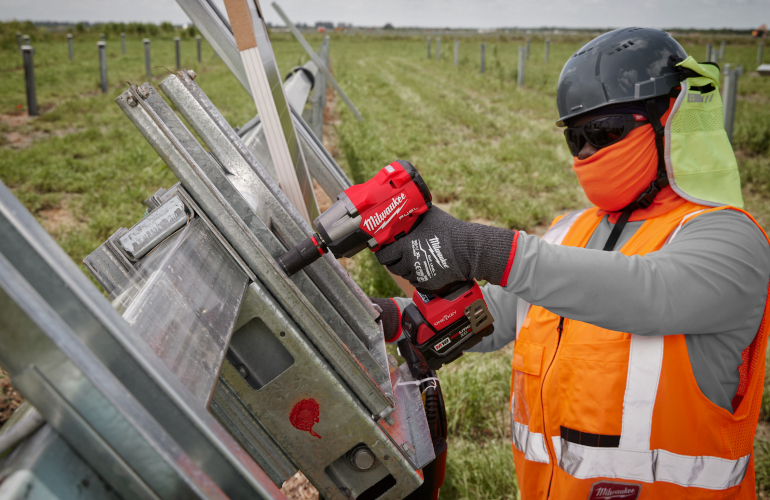Milwaukee Tool shows off its specialty impact tools for solar

Solar Power World has dedicated its March 2024 coverage to installation tips for solar contractors big and small. You can read the rest of our Q&As in the magazine and online here.
For insight into the “hand-held tool” segment, SPW talked with Mark Kelly, senior product manager at Milwaukee Tool, to learn more about the various tools used in the installation of solar projects, from residential rooftop arrays on up to utility-scale facilities with millions of bolts.
Milwaukee recently released a new torque impact wrench developed with input from utility-scale solar installers. What benefits does it bring?
We got a lot of requests from different trades to have an impact wrench where you could magically tell it the torque and it would give that. We realized pretty quickly that solar has the most to gain from a product like that with the amount of wasted time on a jobsite going around and clicking bolts with a mechanical click wrench. We went out to design a product that was durable and powerful but also could control its torque output, with the hopes that they could eventually replace the two-step process and get the repeatability and accuracy they’re looking for.
With most installers today, it’s a guess at the torque, there’s no control. A lot of customers will say they tell their guys to count to two or set the RPM lower, and that prevents it from over torquing. But then it takes 10 seconds to do the application. There wasn’t a good way to control torque with an impact. There are attachments that can limit your torque output like torque sticks. But now you have this long extension and it’s hard to get it where you want it and it’s not giving you a torque value. It’s just trying to get you from overclicking, but you can still under-torque. Accessories aren’t really doing the trick, so a lot of people wanted something that could just be programmed and ready to go.
How have Milwaukee’s tools for solar installers evolved over the years?
“Connected products” is a good opportunity. ONE KEY has been around almost 10 years as a customization, management and reporting platform. The way you do a lot of reporting today is to just manually talk about it, write it down on pen and paper. With our impacts, every trigger pull is recorded so you get a date and time the mode was set in, and you can provide that to your customer to show them the extra effort you went through to control torque on your jobsite vs. we wrote down what we did today. It adds more credibility to what you’re doing.
How do the torque tools used on rooftop/residential solar projects differ from those used on utility-scale?
Most of our tools are designed to cross-trades. But what we’ve seen is that a lot of residential solar installers gravitate toward the smaller M12-type products. When you’re on residential or commercial rooftop projects, your fastener sizes are smaller, you’re dealing with aluminum vs. steel, your tool selection is screwdrivers and drills. Our on a utility site, you’re putting in larger bolts, larger diameter bolts, so you’re using impact wrenches. In utility, there’s a big need for our products for metalworking and concrete, maybe cutting piles to height and drilling new holes into metal piles.








